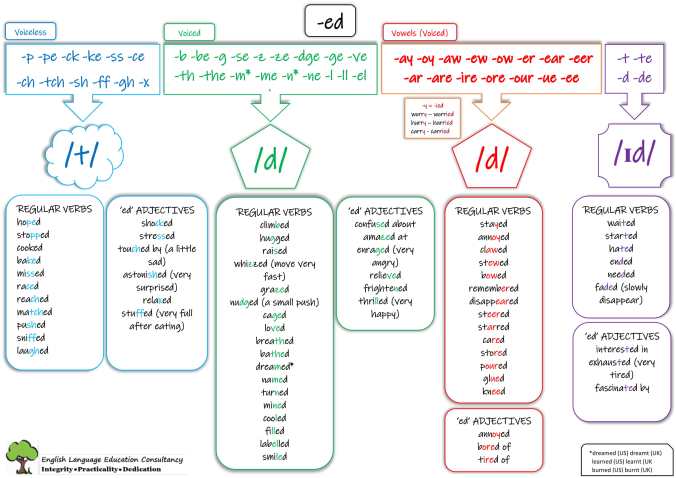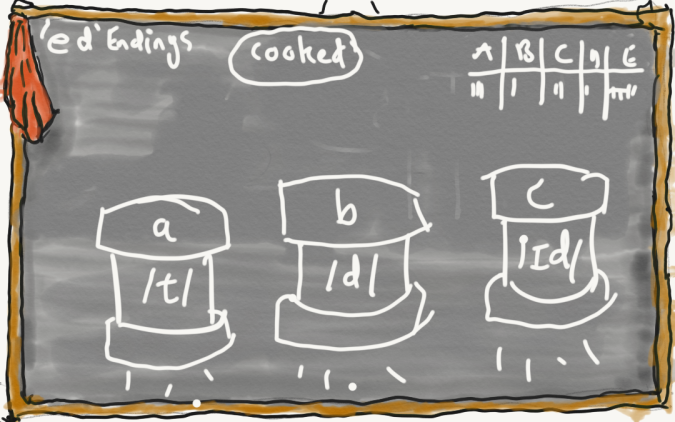Hi teachers. It’s been a long time since the last post. Thank you for returning!
In today’s post we will focus on a nice pronunciation rule for ‘ed’ endings in English. In English many words can end with ‘ed’. For example:
- kicked (to kick)
- punched (to punch)
- hugged (to hug)
- loved (to love)
- wanted (to want)
- needed (to need)
- played (to play)
- called (to call)
Most of these words in English ending with ‘ed’ are Regular Verbs. Regular Verbs are verbs you simply ‘ed’ to when changing them into the Past Simple (Verb 2) form. You can listen to them below.
However, there are some useful ‘ed’ words which look like verbs but act like adjectives. You can test this by adding these ‘ed’ adjectives to ‘I am…’ or ‘I feel…’. Some examples of ‘ed’ adjectives are below:
- amazed by (to be amazed by something)
- excited about (to be excited about something)
- interested in (to be interested in something)
- bored of (to be bored of something)
You can listen to these below:
When you listen to the pronunciation of the examples above you can hear three different pronunciations of the ‘ed’ ending. These are /t/, /d/ and /ɪd/. With /ɪd/ you can hear that it adds an extra syllable to the original word. For example:
- want – wanted
- wait – waited
- need – needed
- fade – faded
Why Different Pronunciations?
So why do some ‘-ed’ endings have a /t/, /d/ or /ɪd/ sound? The answer to this question is in the last letter/s of the word. If you have read some of our previous posts you might have come across the words ‘voiced’ and ‘voiceless’ sounds in English. To keep things simple, ‘voiceless’ sounds make the ‘-ed’ /t/ and ‘voiced’ sounds make the ‘-ed’ /d/. As for /ɪd/ this is easy. /ɪd/ occurs when the last letter/s of the word is ‘-t’, ‘-te’ or ‘-d’, ‘-de’.
The difficulty is knowing which letters in English are ‘voiceless’ and which letters in English are ‘voiced’. Don’t worry, we have made it easy and have produced a nice poster you can use in your class. This can help remind yourself and your students about the ‘ed’ pronunciation rule.

DOWNLOAD HERE: ‘ed’ Ending Pronunciation Wall Poster
Classroom Activities with ‘ed’ Endings.
You can play a nice game with your students by drawing three pipes labelled /t/, /d/ or /ɪd/ on the board:

Then you can write or use word cards above the drawing and get students to decide which pipe that word should go down. If you are using word cards students can come to the board and physically move the card down one of the three pipes.
You can make it more competitive by dividing your class into teams and different students from each team can come to the board and choose which pipe the word should go down.
You can also give points to the teams which choose the correct pipe and give extra points to the team with the best pronunciation too!
Listening Activities with ‘ed’ Endings
A more effective way to help your students develop phonemic awareness (this is your students’ familiarity with the pronunciation patterns in English through listening) might be to do the above activity as a listening activity. So instead of writing or using word cards, you can say the word and students decide which ‘ed’ pronunciation it has.
For example, you say ‘cooked’ and students come to the board (or choose a), b) or c)) and choose the correct pronunciation. They can even repeat the word back to the class.
To make it more challenging you can say the word in root form (this works best with Regular Verbs) and students decide which ‘ed’ pronunciation it would have in its Verb 2 form.
For example, you say ‘cook’ and students decide if it is cooked /t/, cooked /d/ or cooked /ɪd/.
Why Is This Important?
A strong sign of ‘non-native’ like English is with the pronunciation of the ‘ed’ endings. For example, you might hear students pronounce the words below as follows:
- wash – washed
- watch – watched
- stop – stopped
- missed – missed
Can you correct the pronunciation? You can listen below to check:
Interestingly, ‘native English’ speaking children tend to overuse the /ɪd/ pronunciation, but this is usually with Irregular Verbs in Verb 2 form for example:
- buy – buyed, boughted
- go – goed, wented
- hurt – hurted
- eat – eated, ated
Don’t worry about this. Children usually over-generalise language patterns as their language develops over time. Here they are over-generalising the ‘ed’ rule and using it with Irregular Verbs. You might even hear your students doing the same!
The key here, is patience. Use a lot of listening activities to keep your students aware of the ‘ed’ pronunciation rule and they will pick it up over time as their language improves and develops.
Getting your students aware of the different ‘ed’ pronunciations will also help them understand the time references better when listening. For example:
- Who picked these oranges?
- I played badminton.
- They started the game at 6am.
Here, if students become used to hearing the different ‘ed’ endings they know it is referring to the past. Sometimes in English, speakers leave out adverbs such as yesterday, last week, earlier this morning, 2 minutes ago, because the past can be marked with the ‘ed’ ending on Regular Verbs.
If you ae worried your own pronunciation as a teacher, please use the wall poster as a reminder and practise the pronunciation of any target words you will use in your lesson.
Remember that with the /t/ and /d/ pronunciation of the ‘-ed’ ending DO NOT add an extra syllable. For example, listen to the words below. Notice that the number of syllables is the same:
- cook – cooked (might look like ‘cookt’)
/kʊkt/
- beg – begged (might look like ‘begd’)
/begd/
However, with /ɪd/ pronunciation of the ‘-ed’ ending you add an extra syllable. Listen to the words below:
- start – start-ed /stɑ:t/ – /stɑ:t.ɪd/
- cor-rect – cor-rect-ed /kə.rekt/ – /kə.rekt.ɪd/
- nod – nod-ded /nɒd/ – /nɒd.ɪd/
- re-ward – re-ward-ed /rɪ.wɔ:d/ – /rɪ.wɔ:d.ɪd/
So keep your students busy with developing their awareness of the different ‘-ed’ ending pronunciations in English and hope you will notice improvements in process!
Once again, if you found this post useful please LIKE, COMMENT, FOLLOW and SHARE!
Thank you for reading and catch you again soon with our next post!



